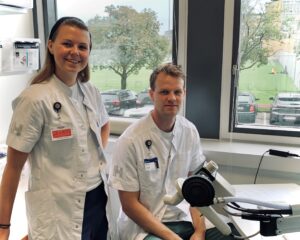The full article can be found here
Tell us more about yourself and the author team.
We are both PhD students at the Centre for Physical Activity Research. Stine has a Master’s in human physiology (2017) from the University of Copenhagen. She has previously worked with patients with metabolic syndrome and focused on the effect of interleukin-6 signalling during exercise. Lately, she has developed a specific interest in pulmonary adaptations to exercise and is now working with patients with COPD. Jacob is an MD from the University of Copenhagen (2018) and has been a practising clinician in anesthesiology and emergency medicine. He entered full-time research in the fall of 2021. Jacob has seen and treated multiple people with respiratory failure sparking an interest in the early treatment of COPD. He specifically focuses on vascular (mal)adaptation in COPD and heart disease and researched genetics and cardiac arrhythmias before graduation.

What is the story behind your study?
Our research focuses on potential pulmonary adaptions to exercise and whether this may benefit patients with COPD. Our theory is that if measurable pulmonary adaptations are to be triggered, the exercise stimulus must be at a high intensity, such as high-intensity interval training (HIIT). Before we pursue this, we must however be sure that HIIT is feasible in our hands and, furthermore, determine whether any of the most widely used HIIT protocols are superior in terms of fidelity and tolerability. Among other things, people with COPD struggle with dynamic hyperinflation during activities. This increases their work of breathing, thus aggravating the dyspnoea that they are experiencing. We, therefore, wanted to see if shorter intervals with very high intensity would be better tolerated compared to the longer intervals with a lower intensity. Since previous exercise intervention studies on patients with COPD generally implemented vastly different interventions, while fidelity and tolerability were only scarcely reported, we conducted the present study to inform the design and conduct of future intervention studies in which patients with COPD are subjected to a HIIT scheme.
In your own words, what did you find?
HIIT is both feasible and tolerable in patients with moderate to severe COPD. We found no difference between the two HIIT protocols used, but the fidelity of the 4×4 protocol was higher compared to the 10×1 protocol. In other words, 4×4 protocols might be easier to implement in settings of pulmonary rehabilitation.
What was the main challenge you faced in your study?
People with moderate to severe COPD are affected by seasonal changes, notably cold and moist weather, which affects their breathing, among other things. Furthermore, they experience pneumonia much more often than lung-healthy people. Another challenge was recruiting patients because HIIT may sound intimidating for some people with COPD, who are often obviously anxious about developing severe dyspnoea during exercise.
If there is one take-home message from your study, what would that be?
HIIT is feasible and tolerable for people with COPD – and they find it both enjoyable and empowering!